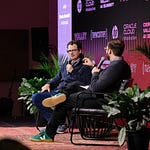The blitzscaling funding model failed news companies.
Vice Media — which raised more than $1 billion from the likes of TPG, Technology Crossover Ventures, and Disney — is reportedly preparing to file for bankruptcy.
BuzzFeed — which raised hundreds of millions of dollars from investors like Andreessen Horowitz, General Atlantic, and NBCUniversal — just shut down its news division and has watched its stock price sink 95% since going public via a SPAC.
Meanwhile, Gawker, which successfully avoided the cash-burning approach, was brought down in a lawsuit funded by tech billionaire Peter Thiel.
This episode of Newcomer is brought to you by Vanta
Security is no longer a cost center — it’s a strategic growth engine that sets your business apart. That means it’s more important than ever to prove you handle customer data with the utmost integrity.
But demonstrating your security and compliance can be time-consuming, tedious, and expensive. Until you use Vanta.
Vanta’s enterprise-ready Trust Management Platform empowers you to:
Centralize and scale your security program
Automate compliance for the most sought-after frameworks, including SOC 2, ISO 27001, and GDPR
Earn and maintain the trust of customers and vendors alike
With Vanta, you can save up to 400 hours and 85% of costs. Win more deals and enable growth quickly, easily, and without breaking the bank.
For a limited time, Newcomer listeners get $1,000 off Vanta. Go to vanta.com/newcomer to get started.
In his new book, Traffic: Genius, Rivalry, and Delusion in the Billion-Dollar Race to Go Viral, former BuzzFeed editor-in-chief Ben Smith takes stock of the heady days of media spending and snarky online writing. (Of course, for all his insistence that that spendy era of media is over, Smith is the co-founder of Semafor, a company that raised $25 million — including about $10 million from Sam Bankman-Fried — to build a new digital media business.)
I invited Smith on the podcast to talk about his new book.
I started the discussion by going back to David Carr’s 2012 profile of BuzzFeed.
Carr wrote at the time:
[W]ith the addition of Mr. Smith and his new hires, BuzzFeed is growing some serious news muscles under a silly, frilly skin, and added the header “2012” for election coverage. (More traditional news verticals will be rolled out in the coming months.) It’s gone well so far, with comScore showing 10.8 million unique visitors in December, more than double that of the same month in 2010.
Its business model, in part, capitalizes on the mix of high and low content; instead of banner ads, BuzzFeed works with companies like Pillsbury to create content ideal for sharing, including “10 Things You Never Knew You Could Do With a Crescent Roll.”
If it is successful, BuzzFeed will generate the kind of traffic that will rival behemoths like, yes, The Huffington Post. Mr. Peretti says that BuzzFeed makes a profit some months, but given the level of investment and growth — there are now 78 people in its Flatiron offices — the burn rate on that new chunk of capital is significant. “It’s fun to watch them make all these hires,” said Choire Sicha, the founder of The Awl site and a veteran of the New York Web scene. “But it’s important that they don’t overspend. Web ad rates are what they are and that isn’t going to change.”
Then I turned the conversation to former Gawker editor Max Read’s review of Traffic.
In the end, only one character in “Traffic” can really be said to have any vision. In 2013, Disney CEO Bob Iger offered to buy BuzzFeed for $650 million. In the book’s strangest and funniest scene, a nightmare blunt rotation of Smith, Peretti, BuzzFeed video chief Ze Frank and BuzzFeed president Jon Steinberg get high on a hotel balcony in Los Angeles and discuss the offer. Frank and Smith urge an ambivalent Peretti to turn down the offer, worrying that “Disney’s corporate culture would stifle” Buzzfeed’s creativity. Not so much Steinberg, the company’s money man, who gets “down on his knees on the balcony to plead with Jonah to take the deal.”
Frank and Smith would go on to win the argument; they and Peretti saw BuzzFeed’s monster traffic as the key to their dreams of a burgeoning, independent media empire. As we now know, they were wrong. Steinberg is far from a genius — after leaving BuzzFeed, he joined the Daily Mail’s U.S. operation, and then founded the cosmically annoying CNBC-for-millennials brand “Cheddar,” whose videos can be found on gas pumps across the country — but he alone managed to see that traffic for what it really was: the “pump” phase of a pump-and-dump scheme that Peretti never had the vision to complete.
In my conversation with him, Smith, the former media columnist for the New York Times, also offered his thoughts on the upcoming presidential primary and Tucker Carlson’s departure from Fox News.
Give it a listen.















Share this post